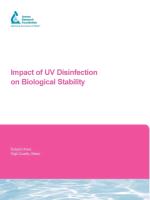Impact of UV Disinfection on Biological Stability
BücherAngebote / Angebote:
Interest in UV disinfection has increased significantly in recent years, due its ability to inactivate Cryptosporidium parvum. Although UV disinfection shows significant promise for inactivation of Cryptosporidium, very few investigations have examined the impact of UV disinfection on biological stability in distribution systems. Biologically stable water is defined as drinking water that does not promote the growth of microorganisms and is typically achieved either through the removal of substrate and/or by providing a secondary disinfectant. At present there is little information concerning potential synergies between UV treatment and secondary disinfectants for improving biological stability.
The overall objective of the research was to evaluate the effect that UV disinfection has on biofilm growth in drinking water distribution systems. In addition, the project's sub-objectives were to (1) determine the potential synergistic effects between primary disinfection with UV treatment and secondary disinfection for controlling bacterial regrowth, (2) compare the effectiveness of chlorine dioxide, free chlorine, and monochloramine for limiting bacterial regrowth in the presence and absence of UV treatment, (3) characterize the chemical intermediates formed during UV/CI2 photocatalysis of natural organic matter, and (4) examine the potential impact of UV/CI2 treatment on the biodegradability of natural organic matter (NOM) for three drinking water utilities.
The research was conducted in three phases: Phase 1 provided a direct comparison of chlorine-¬based disinfectants following UV disinfection, Phase 2 examined the biodegradability of humic material that had been photocatalyzed with UVICI2, and Phase 3 characterized the organic by¬products produced following UVICI2 catalysis of post-filtered water obtained from three water utilities. Phases 1 and 2 were conducted at bench-scale using annular reactors (ARs) to monitor bacterial regrowth. Phase 3 was conducted at bench-scale with a batch biodegradation study to monitor bacterial growth, by-product production, and organic degradation. During Phase 3, post¬filtered water was collected from three water utilities and determination of biodegradability was completed.
Folgt in ca. 15 Arbeitstagen

